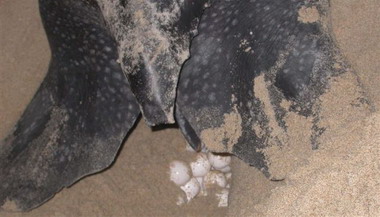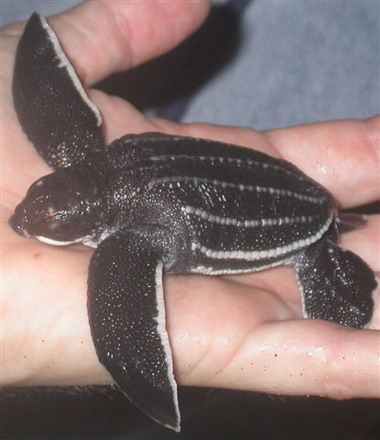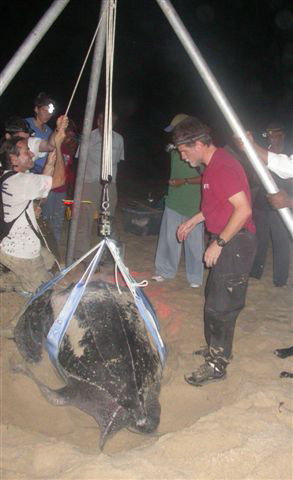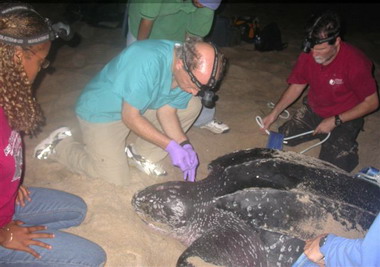John E. Cooper, DTVM, FRCPath, FIBiol, FRCVS
Margaret E. Cooper, LLB, FLS
School of Veterinary Medicine, University of the West Indies, St. Augustine, Trinidad & Tobago
The leatherback turtle (Dermochelys coriacea Linnaeus) is the largest living chelonian: it can reach more than two metres in length and may, on occasion, weigh over 1000 kg. It is widely distributed throughout the world. Its survival in relatively cold waters has been attributed to its specialized powers of thermoregulation - so-called “gigantothermy” (Paladino et al, 1990). However, the leatherback is now listed as ‘Critically Endangered’ in the IUCN Red List (Hilton-Taylor, 2000).
The islands of Trinidad and Tobago are considered to be amongst the most important of the nesting sites of the leatherback (Murphy, 1997). Significant studies on the breeding of the species - and on the need to protect it - were carried out by the late Professor Peter Bacon of the University of the West Indies (UWI) (Bacon, 1981) and various organizations continue to play a part each year in the patrolling and protection of nesting sites (see websites). Nevertheless, turtles are still killed and there are claims, amongst them some strong complaints by visitors, that legislation is weak and law enforcement inadequate in Trinidad and Tobago (Kelly, 2004).
Despite its widespread distribution, remarkably little is known about the health and diseases of the leatherback. Anthropogenic (human-induced) factors are well recognised, amongst them entanglement in fishing nets or damage by fishing hooks. Trauma to the head or carapace, attributed to damage by boats, and also the ingestion of plastic bags were amongst findings reported in Italy (Casale et al, 2003). Eggs (Fig. 2) and hatchlings (Fig. 3) of leatherbacks are susceptible to a variety of insults, including predation and low hatchability associated with unusually high or low temperature or - as is occurring in Trinidad in 2004 - exceptionally heavy and prolonged rainfall. A number of infectious and non-infectious diseases has been reported in marine turtles but relatively little research has been carried out on this species (Mader, 1996), partly because it is difficult to maintain in captivity, in contrast to that of other sea turtles (Whittaker and Krum, 1999).
The need for more work on the leatherback turtle has never been more apparent and it is therefore good to report that the School of Veterinary Medicine (SVM) at UWI, based in Trinidad, has become involved in relevant research. The fields of study in which the SVM is participating are as follows:
- The post-mortem examination of eggs and dead hatchlings in order to obtain data on fertility rates, the types, prevalence and causes of embryonic death and background pathology. These specimens undergo a full necropsy, followed by recommended techniques for the investigation of reptile eggs (Cooper, 2004) including supporting laboratory tests and radiography if appropriate. The SVM is able to provide facilities, equipment and veterinary expertise for such work.
- Collaboration with veterinary colleagues at the University of North Carolina (NCSU), USA (with which the SVM has a Memorandum of Understanding) in their support for the WIDECAST group, led by Dr Scott Eckert (Figure 4), who are studying nesting leatherbacks. One particularly interesting aspect of this work involves the performance of electroretinography (ERG) on nesting female turtles in order to define vision capability. This should help to assess the effect on these animals of the light sticks that are used by fishermen to attract fish but which may also have an adverse influence on turtles. In May 2004 the veterinarian recruited to assist in this work, Dr Craig Harms, contacted the SVM and, in addition to requesting assistance with studies on blood samples from the turtles, invited staff from the School to participate in the research work on Matura Beach, Trinidad (Figure 5). As a result, a group of veterinarians and others from the School were able to participate in the weighing and sampling activities, and blood from leatherbacks was analysed in the SVM's haematology laboratory. This collaboration will continue.
In addition to these specific areas of study above, it is hoped that students and staff of the SVM will participate more fully in 'turtle patrols' in Trinidad. Such patrolling is already an integral part of the programme of the UWI Biological Society, and the aim would be for veterinary and biology students to join forces in future.
There is currently much interest internationally in developing health programmes for threatened wildlife (Anon. 2001). As a result, veterinarians are participating, as partners, in a wide range of ecological and conservation-orientated projects. The developments in Trinidad and Tobago, described briefly above, are to be welcomed. They provide an opportunity for the regional (Caribbean) veterinary school in the English-speaking West Indies to play a role in the conservation and study of an important turtle species. Local and expatriate staff and students will, as a result, develop skills and expertise that may help to halt the decline of a reptile that has survived for millions of years but which now faces serious challenges. The leatherback is sometimes referred to by Trinidadians as the ‘coffin back turtle’ it is to be hoped that this name, based on the animal’s appearance, is in no way an augury for its future survival.
Acknowledgements
I am grateful to colleagues at the School of Veterinary Medicine, UWI, for their enthusiastic input into the work on turtles, especially Drs Carla Phillips and Mervyn Campbell. I thank Drs Scott Eckert and Craig Harms for inviting us to participate in their project and Dr Winthrop Harewood, Acting Director of the SVM, for encouraging the initiative. I am indebted to the BCG for nominating me for the 2003 Kay Gray Award, the receipt of which helped in furthering my interests in Caribbean sea turtles.
The photos were taken by my wife, Margaret Cooper; my thanks are due to her for this and for her continuing support for my various veterinary studies.
References
Anon (2000). Wildlife Health in Conservation. Publication N. 204 Veterinary Continuing Education, Massey University, New Zealand.
Bacon, P. (1981). The status of the sea turtles stock management in the West Central Atlantic. West Central Atlantic Fisheries Commission Studies 7, 1-38.
Casale, P., Nicholosi, P., Freggi, D., Turchetto, M., and Argano, R.(2003). Leatherback turtles (Dermochelys coriacea) in Italy and in the Mediterranean basin. Herpetological Journal 13, 135-139.
Cooper, J.E. (2004). Humane euthanasia and post-mortem examination. In: Manual of Reptiles, edited by S.J. Girling and P. Raiti. British Small Animal Veterinary Association, Gloucester, UK.
Hilton-Taylor, C. (2000). 2000 IUCN Red List of Threatened Species. IUCN Gland Switzerland/Cambridge, UK.
Kelly, M. (2004). Sad plight of Tobago sea turtles. Correspondence. Sunday Guardian (Trinidad) January 11th, 2004.
Mader, D. R. (1996). Reptile Medicine and Surgery. Saunders, Philadelphia, USA.
Murphy, J.C. (1997). Amphibians and Reptiles of Trinidad and Tobago. Krieger, Florida, USA.
Paladino, F.V., O'Connor, M.P. and Spotila, J. R. (1990). Metabolism of leatherback turtles gigantothermy, and thermoregulation of dinosaurs. Nature 344, 858-860.
Whittaker, B.R. and Krum, H. (1999). Medical management of sea turtles in aquaria. In: Fowler, M.E. and Miller, E. Diseases of Zoo Animals and Wildlife. Saunders, Philadelphia, USA.
Useful websites:
http://www.widecast.org/widecast/widecast.cfm
http://www.seaturtle.org/mtn/archives/mtn62/mtn62p12.shtml
http://www.sos-tobago.org/tobagoturtles.html
http://www.buccooreef.org/
http://www.bonairenet.com
http://www.leatherback.org
http://www.mcsuk.org/cgi-bin/search/search.pl?Terms=leatherback
Testudo Volume Six Number One 2004
Top





